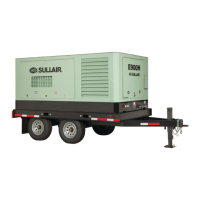5: Operation E900H User Manual
02250203-986 R03
40 Subject to EAR, ECCN EAR99 and related export control restrictions.
5.3 Initial start-up procedure
1. Place machine in level, suitable area and
chock the wheels.
2. Ensure that red shipping studs are loosened
and not supporting the motor or compressor
unit.
3. Connect power to machine. See Section 4.2:
Electrical preparation on page 37.
4. Check compressor fluid level. See Section
4.1: Fluid level check on page 37.
5. Fully open the air service valve.
6. Turn on main power supply and disconnect
on machine. At this time, the power indicator
light shall be on and the machine is ready to
start.
7. Check Phase/Voltage Fault indicator. If lit,
disconnect power and switch two of the
phases. See Section 5.7 for more details.
8. Depress start button and observe. If machine
starts, the run indicator light will be on and
the electrical connection is correct. Verify
proper rotation of compressor and fan.
9. Once machine is started, verify that it
unloads at the rated pressure.
Phase monitor relay
Prevents the compressor from starting with incorrect phase order, loss of
phase and under or over voltage.
Phase / voltage fault indicator
This indicator is lit when the phase/voltage relay detects incorrect phas-
ing or a voltage fault. See Section 5.7 for details.
Ground fault protector
The protector contact will trip on the 110V circuit if a ground fault is
detected. This will shut down the compressor or prevent it from starting.
Pressure regulator
(LOAD chamber)
Maintains a maximum pilot pressure of 60 psig (4.1 bar).
Pressure regulator
(UNLOAD chamber)
Opens a pressure line between the sump and the inlet unload chamber,
allowing the inlet valve to regulate air delivery according to air demand.
Solenoid valve
Electrically actuated 3-way solenoid valve used to open the blowdown
valve and pressurize the unload port/close the inlet valve during shut-
down.
Start control valve
Opens when the wye-delta timer closes; closes when the wye-delta
timer is open. Opens a pressure line between the sump and inlet load
chamber allowing the inlet valve to deliver air.
Pneumatic inlet valve
Regulates the amount of air being delivered. Also blocks reverse flow
upon shutdown.
Minimum pressure/check valve
Maintains a minimum pressure in the receiver tank. Prevents backflow
from the system during shutdown or unload.
Blowdown assembly valve Vents receiver tank pressure during unloading and shutdown.
Thermal valve
Regulates flow of fluid to the cooler in order to minimize warm up time
and maintain a minimum operating temperature to avoid condensation.
Fluid level sight glass
Used to monitor fluid level. Proper level is always visible in the sight
glass. Check the level when the compressor is shutdown.
Separator return line sight glass
Indicates fluid flow from the separator scavenge. Flow should be visible
during full load; little to no flow when unloaded. Sluggish full load flow
indicates a need to clean the strainers fitted to the return lines.
Pressure relief valve
Opens receiver tank pressure to atmosphere if receiver tank pressure
exceeds relief valve setting.
Recirculation valve
Provides limited air supply back to inlet valve during unload conditions to
prevent cavitation in unit.
Control or indicator Purpose

